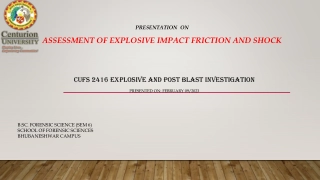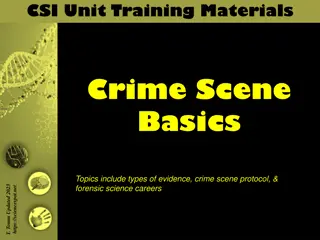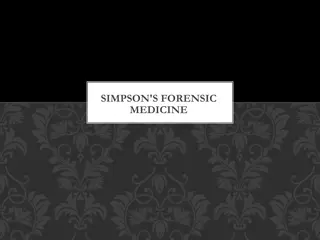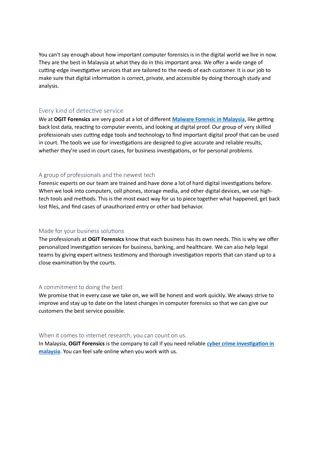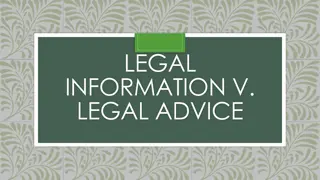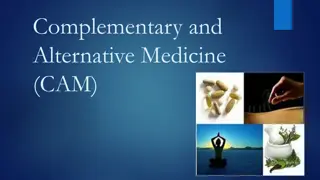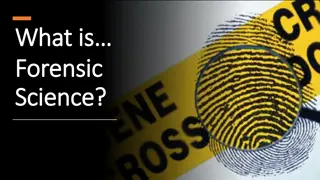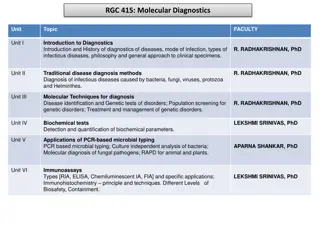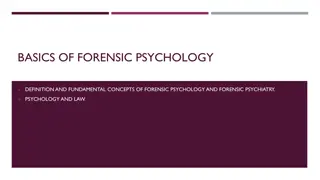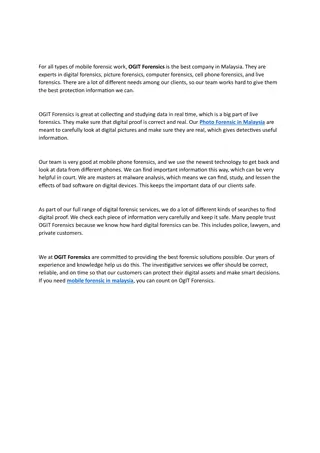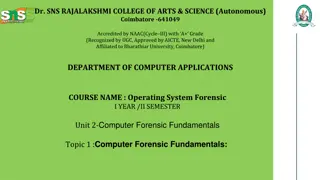Forensic Medicine: Legal Aspects and Autopsy Procedures
Forensic medicine, also known as legal medicine, encompasses various fields such as forensic pathology, odontology, and psychology. This branch of medicine involves determining causes of death within the legal system, identifying diseases and injuries, and studying wounds. Key topics include DNA profiling, body identification, and crime scene investigation. Explore the history, culture, and religion of forensics and PME. Discover the significance of autopsies and who can request them under legal mandates.
Download Presentation

Please find below an Image/Link to download the presentation.
The content on the website is provided AS IS for your information and personal use only. It may not be sold, licensed, or shared on other websites without obtaining consent from the author.If you encounter any issues during the download, it is possible that the publisher has removed the file from their server.
You are allowed to download the files provided on this website for personal or commercial use, subject to the condition that they are used lawfully. All files are the property of their respective owners.
The content on the website is provided AS IS for your information and personal use only. It may not be sold, licensed, or shared on other websites without obtaining consent from the author.
E N D
Presentation Transcript
FORENSIC MEDICINE : How do we translate ?? Legal medicine,,,,, forensics Autopsy , PME
OUR SCOPE PME TO DETERMINE COD LEGAL SYSTEM DISEASE & INJURY IDENTIFECATION. WOUNDS
KEY WORDS: (SUGGESTIONS TO BE USED IN SEARCHES): Forensic, forensics, forensic pathology, forensic medicine, forensic odontology, forensic dentistry, forensic anthropology, forensic psychiatry, forensic psychology, Forensic archaeology, Forensic entomology, Forensic botany, Forensic criminalistics, Ballistics, Ballistic fingerprinting, Body identification, DNA profiling, Fingerprint analysis, Forensic accounting, Forensic arts, Forensic footwear evidence, Forensic toxicology, Questioned document examination, Vein matching, Digital forensics, telemedicine, telepathology, forensic informatics, Computer forensics, Database forensics, Mobile device forensics, Network forensics, death, cause of death, sudden death, unexpected death, manner , manner of death, homicide, suicide, accident, accidental death, fatal, fatality, mortal, mortality, identification, identifying, sports medicine (and injuries, trauma, death, fatal, fatalities, mortality), Fire investigation, fire, accelerants, Forensic engineering, Forensic linguistics, Forensic materials engineering, Forensic polymer engineering, Vehicular accident reconstruction, Crime scene, CSI effect, Perry Mason syndrome, Pollen calendar, Skid mark, Trace evidence, DNA in forensic entomology, etc.
THE WEB SITES The web sites: (suggestions to be used in searches): 1. http://www.medscape.com 2. http://scholar.google.com/ 3. http://www.ncbi.nlm.nih.gov/pubmed/ 4. ,,,,,,,,,,,,,, 5. ,,,,,,,,,,, 6. ,,,,,, 7. ,,, 8. ,
SUGGESTIONS FOR TITLES: SUGGESTIONS FOR TITLES: History, religion and culture of forensics and PME: History, religion and culture of forensics and PME: In Islam In other Religions/Cultures In the Holy Quran, Hadeeth History Previous scientists (e.g. Ibn Al-Nafis)
WHO REQUESTS AN AUTOPSY? ((PERMISSION)) In some cases, the law may mandate that an autopsy be performed ( Forensic Autopsy ). In all other cases, permission is required, cannot be performed without consent. It can be requested either by the patient s physician ( medical autopsy ) or by the family ( private autopsy ). - When giving consent, the family may make any restrictions, limitations, or special requests
TYPE OF AUTOPSIES Medical Forensic Private
WHAT IS AN AUTOPSY ? Postmortem examination of the organs and tissues of a body to determine cause of death or pathological conditions. an external and internal examination of the body after death using surgical techniques. performed by a forensic pathologist. Takes { 2 4 } hours to perform.
WHAT IS AN AUTOPSY ? May be May be Invasive. mini-invasive. non-invasive procedures. May be May be Comprehensive limited to a particular organ system. Small samples of each organ are taken: Small samples of each organ are taken: for microscopic examination , (malignancy or infection .. for studying genes. for checking for drugs, chemicals, or toxic substances. The performance of an autopsy should not delay a funeral or affect viewing of the The performance of an autopsy should not delay a funeral or affect viewing of the body. body.
SUGGESTIONS FOR TITLES: SUGGESTIONS FOR TITLES: Postmortem examination (PME) and autopsy: Postmortem examination (PME) and autopsy: Autopsy ethics: Autopsy procedure: Limited: Minimally invasive: Virtopsy: Techniques:
SUGGESTIONS FOR TITLES: SUGGESTIONS FOR TITLES: Sub-specialised PME: Molecular autopsy: Perinatal: Natural deaths: Research: Negative autopsy:
TITLES: TITLES: Forensic topics in KSA Forensic topics in KSA: Drowning , carbon monoxide , death of females of child bearing age ~14-44 years of age, "accidental" fire arm injury, residential injuries, occupational injury, ASCAD, DM, congenital disease, drug abuse, psychiatry, prisons, orphanages, death of Saudis abroad, asthma/allergies, biochemical industry, farming, unclaimed bodies, improper death certification.
FORENSIC AS RELATED TO OTHER HEALTH SPECIALTIES AND MINISTRY OF HEALTH: Paramedics: PME as a quality assurance, Documentation of evidence of resuscitation ER: Death certification, PME as a quality assurance, Documentation of evidence of resuscitation Plastic surgery: Burns, wounds, documentation of injuries, identification. Ortho: Documentation of injuries, identification, causes of death; PE, fat embolism. Ob/Gyn: Sexual offences, abortion, abuse, recurrent fetal loss, perinatal PME Using Colposcopy in the Rape Exam: Health Care, Forensic, and Criminal Justice Issues ICU: Death certification, PME as a quality assurance, Documentation of evidence of resuscitation
FORENSIC AS RELATED TO OTHER HEALTH SPECIALTIES AND MINISTRY OF HEALTH: CCU: Death certification, PME as a quality assurance, Documentation of evidence of resuscitation Anesthesia: Death certification, PME as a quality assurance, Documentation of evidence of resuscitation Cardiology: Death certification, PME as a quality assurance, Documentation of evidence of resuscitation Cardiac surgery: Death certification, PME as a quality assurance, Documentation of evidence of resuscitation Neurosurgery: Death certification, Documentation of injuries, PME as a quality assurance, Documentation of evidence of resuscitation Neurology: Degenerative diseases, infectious disease.
FORENSIC AS RELATED TO OTHER HEALTH SPECIALTIES AND MINISTRY OF HEALTH: Pediatric: Abuse, neglect, Shaken baby syn., SIDS, PME and congenital disease diagnosis, inherited disease. Cranial Computed Tomographic Findings in a Large Group of Children With Drowning: Diagnostic, Prognostic, and Forensic Implications. Geriatric. Degenerative disease, Abuse, Neglect. Forensic Biomarkers of Elder Abuse: What Clinicians Need to Know. Psychiatry: Drug abuse, psychiatric disease psychosis in forensics, excited delirium. Caring for Convicts.
FORENSIC AS RELATED TO OTHER HEALTH SPECIALTIES AND MINISTRY OF HEALTH: infectious disease: Public health, PME, H1N1, SARS, caring for convicts. Ophthalmology: Retinal examination, Shaken baby syn. Vascular surgery: PME in Aneurysm, Dissection, Aortic Dissection and Marfan's Fatal Invasive Cervical Cancer Secondary to Untreated Cervical Dysplasia. Oncology: death, mortality, effects of treatment, cervical cancer fatality. Medical staff of a hospital, Hospital Administrator and governmental agencies monitoring health care: Provides a quality control mechanism, a final yardstick by which the care of a patient can be measured
FORENSIC AS RELATED TO OTHER HEALTH SPECIALTIES AND MINISTRY OF HEALTH: Researcher: A source of new ideas as to cause of disease May also provide an evaluation of new procedures and new therapeutic agents, and an explanation of adverse reactions, with the hope that they can be prevented in the future
FORENSICS RELATED TO OTHER MINISTRIES Military. MOI: Police: Commission for the Promotion of Virtue and Prevention of Vices. Fire department: Border and Customs: Correctional institutions:
FORENSICS RELATED TO OTHER MINISTRIES Evaluation of new weaponry; TASER, biological, etc. Evaluation of safety measures (for officers and transportation). Evaluation of security measures. Identification of previously known and unknown individuals. Excited delirium. Deaths of officers, prisoners, orphans.
OTHER TOPICS: Mass disaster Medical errors Quality assurance CSI effect/syndrome Education Research
OTHER TOPICS: Sports, head injuries, cardiac disease, tests, cause of death. Terrorism. Occupational health. Industry. Transportation, car, plane, aquatic Forensic awareness program: KG, elementary, junior high, high school, College University, health colleges, police, military, fire department.....
OTHER TOPICS: Epidemiology: qualitative, quantitative studies Testing: military, drugs, treatments Safety: cars, planes, trains, high rise apartments/buildings, schools, hospitals, psychiatric intitutes Genetic disease, heart disease, infectious disease Drug trafficking, human trafficking, other.
WHY PERFORM AN AUTOPSY? Although the primary reason to perform an autopsy is to determine cause of death, there are other benefits to individual, families, the practice of medicine, and the community at large. to answer any questions the law, the family or physician may have about the illness, cause of death, and/or any co-existing conditions. The autopsy is important to providing an understanding of the quality of patient care.
FORENSIC BENEFITS In investigation of homicide, suspected homicide, other unexplained or suspicious deaths, and deaths apparently due to accident or injury. addition, there are forensic benefits of
MANNER OF DEATH Homicide. Homicide. Accidental. Accidental. Natural. Natural. Suicide Suicide Undetermined. Undetermined. Unclassified. Unclassified.
HOW FAMILIES BENEFIT FROM THE AUTOPSY Discovering inherited or familial diseases Discovering inherited or familial diseases may help families through early diagnosis and treatment & family planning Discovering an infectious disease Discovering an infectious disease may lead to early diagnosis and treatment & to help other family members and close contacts ( TB ). Uncovering evidence of a work Uncovering evidence of a work- -related disease related disease might lead to compensation for the family. Providing crucial information for the settling of insurance claims or death benefits Providing crucial information for the settling of insurance claims or death benefits may result in benefits for the family Confirming a specific cause of death Confirming a specific cause of death may simply ease the stress of the unknown. Finding that diagnosis and treatment was appropriate Finding that diagnosis and treatment was appropriate may be comforting to the family. Knowledge that information gained by the autopsy Knowledge that information gained by the autopsy may help someone else to live longer may ease the profound sense of loss experienced by families. understand what has happened to their loved one is by performing an autopsy
HOW COMMUNITIES BENEFIT FROM AUTOPSIES Increasing knowledge about causes and course of an illness and effects of different types of treatment. Explaining the causes of injuries and accidents involving automobiles, falls, or other situations. Providing information about preventable causes of disease and accident and other public health hazards Helping to establish the cause and manner of death, which at times may be required by law. The autopsy is important to providing an understanding of the quality of patient care to monitor health system. Medical education, training and research leading to improved health care
ARE THERE RELIGIOUS CONFLICTS? YES VS NO YES VS NO
THE FINAL REPORT: It takes several weeks. It takes several weeks. a permanent part of the patient a permanent part of the patient s medical record. s medical record. The findings may be discussed with the family physician or with the pathologist. The findings may be discussed with the family physician or with the pathologist.
Theeb Theeb Alkahtani Alkahtani dr_theeb@hotmail.com Text: 966557228228 966500520242


